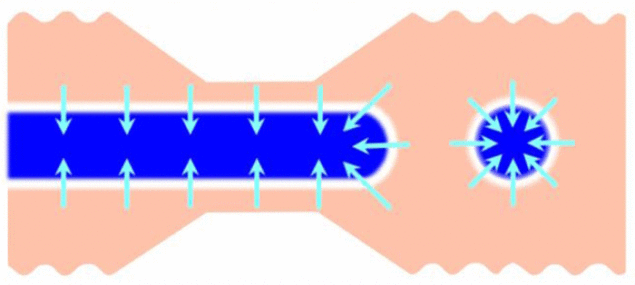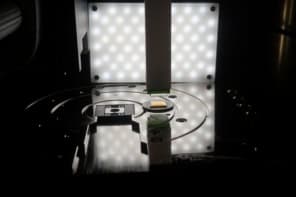
The capacity of computer memory could be boosted by exploiting tiny magnetic vortices known as skyrmions. That is the vision of physicists in the US, who have made individual skyrmion “bubbles” at room temperature by pushing magnetic domains through a narrow gap in a thin ferromagnetic-metal film – just as bubbles can be made by blowing on a soap-covered gap.
Skyrmions are particle-like regions within a field where all of the field vectors point either towards or away from a single point – a bit like the way in which spines are arranged on a hedgehog. Skyrmions were originally proposed in the 1950s by British physicist Tony Skyrme, who found they could explain the emergence of protons and neutrons from the field that mediates the strong nuclear force. But while skyrmions never really took off in particle physics, their underlying mathematics has been applied to other areas of physics.
The crucial point about a skyrmion is that it is topologically stable. This means that, while its shape can be altered, the “twistedness” of a skyrmion cannot be broken without first removing the singularity that holds it together. This resembles the behaviour of a Möbius strip, which must be cut if it is to be transformed into a normal loop – no amount of bending will do the job.
Tiny yet stable memory
This is a quality that could make skyrmions ideal for use in computer memory. Hard disks work by encoding 0s and 1s using the direction of atomic magnetic moments within small regions, or domains, on the surface of a ferromagnetic material. But there is a limit to how small these domains can be made before the magnetization becomes unstable. The great stability of skyrmions means they could potentially occupy far smaller areas – having dimensions of just a few nanometres, rather than the roughly 50 nm of today’s best drives – and the very small electric current needed for their operation means they would consume less energy.
In the latest research, Axel Hoffmann of the Argonne National Laboratory in Illinois and colleagues have made a device consisting of a very thin layer of a cobalt-iron-boron alloy – a ferromagnet – sandwiched between layers of tantalum metal and tantalum oxide. They pattern this multilayered film so as to create a wire 60 μm wide with a narrow (3 μm) constriction about halfway along.
Normally, the magnetic moments of electrons within a thin film of ferromagnetic material point along the plane of the film, but the layered structure of this device orients those moments perpendicular to the plane. The researchers apply a magnetic field to create a long “stripe” of domains with upward-pointing magnetization, surrounded by areas of opposing magnetization, and then switch on an electric current flowing from left to right along the wire.
That current exerts a force on the magnetic domains, moving them to the right. But since the current cannot flow outside of the wire, it is constrained to funnel through the constriction, thus introducing a vertical component to its left–right motion. That in turn pushes the sides of the stripes outwards as the latter emerge from the narrow gap. This expansion continues until the head of each stripe forms a bubble shape that then breaks off and continues to move rightwards (see figure).
“This bubble disconnects, just like an expanding soap bubble or a drop from a dripping tap,” explains Hoffmann. “It has the exact topological structure of a magnetic skyrmion.”
Everyday materials
A significant advantage of this scheme over alternative ways of generating skyrmions, says Hoffmann, is its use of transition metal alloys and other metallic films that are already found in commercial memory devices. The device also operates at room temperature, so doing away with the need for expensive refrigeration equipment. In addition, he says, whereas skyrmions are usually manipulated within lattices, here they have been isolated.
According to Hoffmann, these skyrmions could have a number of uses. One would be to make logic gates. An AND gate, for example, could potentially consist of two joined wires that would generate an output only if skyrmions were present in both wires. However, the most straightforward application would be encoding data using the presence or absence of skyrmions. In particular, “racetrack memory”, which involves reading and writing to mobile magnetic domains on a fixed wire, suffers from the fact that stripe-shaped domains can easily be corrupted by defects in the wire. Point-like skyrmions, in contrast, could move around such defects, he says.
Kirsten von Bergmann of the University of Hamburg in Germany, whose group in 2013 reported having created and destroyed skyrmions on a thin film of palladium and iron, praises the latest work, which she says is “a significant step towards implementation” of real devices. But she cautions that significant hurdles remain, including the need for better control over the positioning and movement of individual skyrmions. Also crucial, she says, is size. The American group has produced skyrmions with a diameter of about 1 μm, which is one to two orders of magnitude too large to be useful, she estimates.
Hoffmann acknowledges this shortcoming but believes it can be overcome. He says that other research groups have been able to make room-temperature skyrmions as small as 100 nm across (the greater thermal energy at higher temperatures perhaps making it more difficult to prevent small skyrmions from unwinding). Reducing the scale by another factor of 10, he says, “is not so unrealistic”.
The research is reported in Science.



